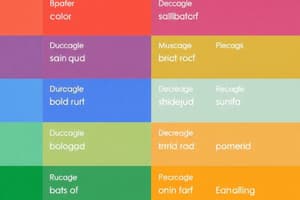Podcast
Questions and Answers
Which type of adjectives would describe features like size, shape, and layout of an apartment?
Which type of adjectives would describe features like size, shape, and layout of an apartment?
- Aesthetic adjectives
- Atmospheric adjectives
- Functional adjectives
- Physical adjectives (correct)
What type of adjectives would best describe the emotional environment an apartment creates?
What type of adjectives would best describe the emotional environment an apartment creates?
- Functional adjectives
- Physical adjectives
- Aesthetic adjectives
- Atmospheric adjectives (correct)
Which of the following is an example of a functional adjective to describe an apartment?
Which of the following is an example of a functional adjective to describe an apartment?
- Energetic
- Efficient (correct)
- Modern
- Spacious
An example of an aesthetic adjective used to describe an apartment could be:
An example of an aesthetic adjective used to describe an apartment could be:
The color theory mentioned in the text primarily influences the ____ of an apartment.
The color theory mentioned in the text primarily influences the ____ of an apartment.
How do adjectives influence decision-making when choosing an apartment?
How do adjectives influence decision-making when choosing an apartment?
What are primary colors?
What are primary colors?
Which color scheme involves colors that create contrast?
Which color scheme involves colors that create contrast?
What do warm colors include?
What do warm colors include?
Which combination creates a sense of calm or tranquility?
Which combination creates a sense of calm or tranquility?
Which color is often associated with trust and dependability?
Which color is often associated with trust and dependability?
What are secondary colors?
What are secondary colors?
Study Notes
Adjectives, Colors, and Apartments
When you're searching for a new place to call home, the physical location and amenities are crucial, but so is the "feel" of the apartment. The colors and adjectives used to describe the space can significantly influence your decision. This article delves into the world of adjectives and color theory to help you understand how they shape the aesthetic experience and ambiance of an apartment.
Types of Adjectives
Adjectives are words that modify a noun and provide more information about it. In the context of apartments, adjectives can describe various features, from the practical to the aesthetic.
- Physical adjectives: These describe the physical attributes of the apartment, such as size, shape, construction, and layout. Examples include "spacious," "cozy," "modern," "vintage," and "luxurious."
- Atmospheric adjectives: These describe the emotional or psychological environment that the apartment creates. Examples include "serene," "energetic," "soothing," or "exciting."
- Functional adjectives: These describe the practical uses and purposes of the apartment. Examples include "efficient," "flexible," "organized," or "convenient."
- Aesthetic adjectives: These describe the visual appeal or design elements of the apartment. Examples include "elegant," "stylish," "minimalist," or "eclectic."
Color Theory
Color theory is a fundamental aspect of design that deals with how colors interact with each other and evoke emotions and sensations. Understanding color theory can help you make informed decisions about the aesthetic appeal of an apartment.
- Primary colors: These colors are red, blue, and yellow. They are foundational and cannot be created by mixing other colors.
- Secondary colors: These colors are green, orange, and purple. They result from mixing primary colors.
- Tertiary colors: These colors are made by mixing primary and secondary colors.
- Complementary and analogous colors: These color schemes involve two colors that create contrast or harmony, respectively.
- Warm and cool colors: Warm colors include reds, oranges, and yellows and create a sense of warmth or energy. Cool colors include blues, greens, and purples and create a sense of calm or tranquility.
- Color psychology: Understanding how colors affect people can help you choose the right colors for your apartment. For example, blue is often associated with trust and dependability, while red is associated with energy and excitement.
Combining Adjectives and Colors
Using adjectives and colors in combination can create a powerful and unique aesthetic experience in an apartment.
- Cool and calming: Painting walls in pale blues or greens and using adjectives like "serene" or "soothing" can create a peaceful atmosphere.
- Warm and inviting: Painting walls in warm yellows, oranges, or reds and using adjectives like "cozy" or "welcoming" can create a sense of warmth and comfort.
- Energetic and vibrant: Painting walls in bright reds, oranges, or yellows and using adjectives like "exciting" or "energetic" can create a sense of vitality and enthusiasm.
- Minimalist and modern: Painting walls in cool grays or whites and using adjectives like "sleek" or "streamlined" can create a sense of simplicity and sophistication.
- Eclectic and unique: Using a mix of colors and adjectives can create a sense of personal expression and individuality.
In conclusion, understanding adjectives and color theory can help you make informed decisions about the aesthetic appeal of an apartment. By combining adjectives and colors, you can create a powerful and unique atmosphere that speaks to your personality and preferences. Whether you're looking for a calm and serene space or an energetic and vibrant one, understanding adjectives and color theory can help you find the perfect apartment for you.
Studying That Suits You
Use AI to generate personalized quizzes and flashcards to suit your learning preferences.
Description
Explore the world of adjectives and color theory to understand how they shape the aesthetic experience and ambiance of an apartment. Learn about different types of adjectives describing apartments and the basics of color theory to make informed decisions about the visual appeal of a living space.




